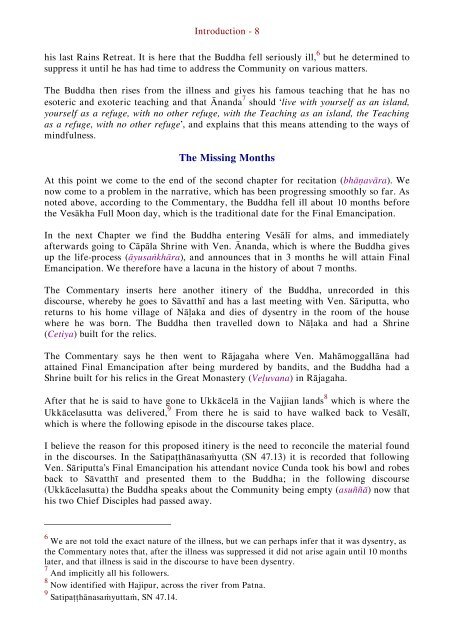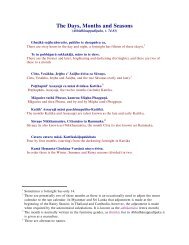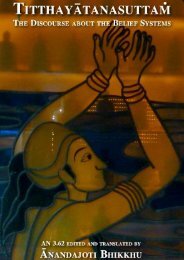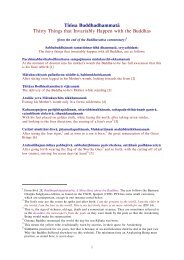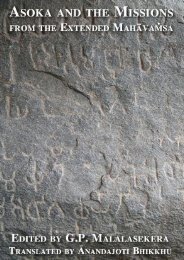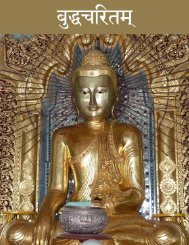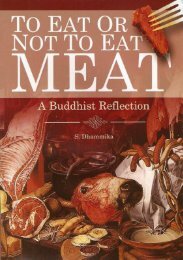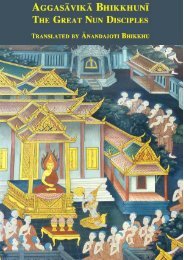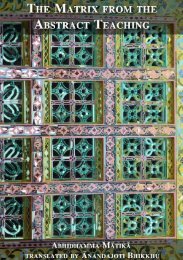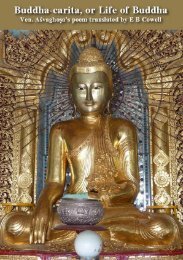Mahaparinibbanasuttam (DN 16) - Ancient Buddhist Texts
Mahaparinibbanasuttam (DN 16) - Ancient Buddhist Texts
Mahaparinibbanasuttam (DN 16) - Ancient Buddhist Texts
You also want an ePaper? Increase the reach of your titles
YUMPU automatically turns print PDFs into web optimized ePapers that Google loves.
Introduction - 8<br />
his last Rains Retreat. It is here that the Buddha fell seriously ill, 6 but he determined to<br />
suppress it until he has had time to address the Community on various matters.<br />
The Buddha then rises from the illness and gives his famous teaching that he has no<br />
esoteric and exoteric teaching and that Ānanda 7 should ‘live with yourself as an island,<br />
yourself as a refuge, with no other refuge, with the Teaching as an island, the Teaching<br />
as a refuge, with no other refuge’, and explains that this means attending to the ways of<br />
mindfulness.<br />
The Missing Months<br />
At this point we come to the end of the second chapter for recitation (bhāṇavāra). We<br />
now come to a problem in the narrative, which has been progressing smoothly so far. As<br />
noted above, according to the Commentary, the Buddha fell ill about 10 months before<br />
the Vesākha Full Moon day, which is the traditional date for the Final Emancipation.<br />
In the next Chapter we find the Buddha entering Vesālī for alms, and immediately<br />
afterwards going to Cāpāla Shrine with Ven. Ānanda, which is where the Buddha gives<br />
up the life-process (āyusaṅkhāra), and announces that in 3 months he will attain Final<br />
Emancipation. We therefore have a lacuna in the history of about 7 months.<br />
The Commentary inserts here another itinery of the Buddha, unrecorded in this<br />
discourse, whereby he goes to Sāvatthī and has a last meeting with Ven. Sāriputta, who<br />
returns to his home village of Nāḷaka and dies of dysentry in the room of the house<br />
where he was born. The Buddha then travelled down to Nāḷaka and had a Shrine<br />
(Cetiya) built for the relics.<br />
The Commentary says he then went to Rājagaha where Ven. Mahāmoggallāna had<br />
attained Final Emancipation after being murdered by bandits, and the Buddha had a<br />
Shrine built for his relics in the Great Monastery (Veḷuvana) in Rājagaha.<br />
After that he is said to have gone to Ukkācelā in the Vajjian lands 8 which is where the<br />
Ukkācelasutta was delivered, 9 From there he is said to have walked back to Vesālī,<br />
which is where the following episode in the discourse takes place.<br />
I believe the reason for this proposed itinery is the need to reconcile the material found<br />
in the discourses. In the Satipaṭṭhānasaṁyutta (SN 47.13) it is recorded that following<br />
Ven. Sāriputta’s Final Emancipation his attendant novice Cunda took his bowl and robes<br />
back to Sāvatthī and presented them to the Buddha; in the following discourse<br />
(Ukkācelasutta) the Buddha speaks about the Community being empty (asuññā) now that<br />
his two Chief Disciples had passed away.<br />
6 We are not told the exact nature of the illness, but we can perhaps infer that it was dysentry, as<br />
the Commentary notes that, after the illness was suppressed it did not arise again until 10 months<br />
later, and that illness is said in the discourse to have been dysentry.<br />
7 And implicitly all his followers.<br />
8 Now identified with Hajipur, across the river from Patna.<br />
9 Satipaṭṭhānasaṁyuttaṁ, SN 47.14.


